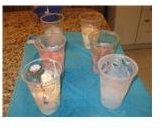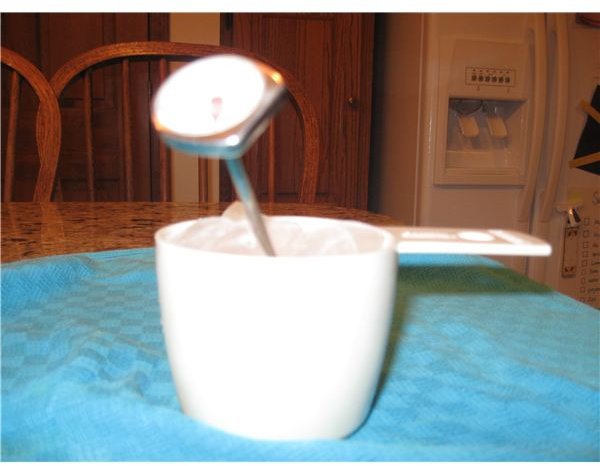3 Science Experiments on How Things Melt: Ice Cubes and Ice Cream
Which Melts Faster: Ice Cubes Or Ice Cream?
One of my absolute all-time favorite treats is ice cream. Last night I ate a bowl of French vanilla with fresh raspberries from our
garden, and a few nights before it was peanut butter and chocolate ice cream in my bowl. This assignment gave me a chance to study ice cream in its finer, scientific form. In this fun hands-on science project, ice cream and ice cubes are going to race to see which one will melt the fastest.
Did you know the U.S. Department of Agriculture says that to get an official stamp of approval, ice cream has to contain 10 percent milk fat, a minimum of 6 percent non-fat milk solids, and a gallon has to weigh 4.5 pounds? For this experiment, make sure to buy real ice cream, because even the low-fat versions aren’t always considered the same. Some of the elements that affect how ice cream melts are the fats, sweeteners and ice crystal size. Ice cream has a complex structure, but then again, so does water.
Water, like all things, is made up of atoms. Atoms are tiny and they are all around us. There are 100 different types of atoms; water contains two: oxygen and hydrogen. The freezing point for water is 32 degrees Fahrenheit or 0 degrees Celsius. Once this liquid is frozen, the atoms stop flowing freely, but once they melt, they flow again.
For this project, you will be conducting three different experiments.
- Ice cream will take on ice cubes to see which one melts the fastest.
- Two flavors of ice cream will compete for the fastest melting time.
- Ice cream will challenge crushed ice.
Below you will find a list of all the supplies you need to do these experiments at home, and at the end of the experiments, you will find out why the winners take the prize in scientific terms.
Items Needed For This Experiment

You’ll need the following items to begin:
- 6 clear, plastic cups
- Water
- 2 cups of one flavor of ice cream
- 1 cup of an alternate flavor of ice cream
- 2 cups of ice cubes
- 1 cup of crushed ice
- Food thermometer
- Measuring cup
- Paper and pencil to record data
- Towel (optional, for cleaning up any spills)
The Race Is On
-
Before you begin, as a word of caution: Make sure to allow at least an hour and a half to complete the experiments as the melting time could take that long.
-
For this project, you’ll be doing three different tests involving ice cream and ice cubes. The first thing you’ll want to do is make a chart to record the data from each test. The columns along the top are Experiment, Ice Cream Melt Time, Temperature Before, Temperature After, Ice Cube Melt Time, Temperature Before and Temperature After. The columns along the side are the names of the three experiments which are Ice Cream vs. Ice Cube, Flavor Race, and Ice Cream vs. Crushed Ice.
-
Next, at the bottom of the chart, make a hypothesis about which product you think will win each race. A hypothesis is an educated guess, which includes your prediction for the outcome.
-
For the first race, you’ll need to measure out one cup of ice cream into a plastic cup. Make sure the cup is leveled straight off at the top for a more accurate race.
-
Next, measure out one cup of ice cubes into a plastic cup.

-
Take the temperature of the solids in each cup for 20 seconds to get an accurate reading, and record the data on the chart.
-
Write down the starting time for each race as it begins.
-
Next, measure out one cup of two different flavors of ice cream into the plastic cups for the flavor race and record the temperatures and starting time for this race.
-
For the last race, measure out one cup of ice cream and one cup of crushed ice into plastic cups. Once again, record the temperatures and starting time.
-
Monitor the cups every 5 to 10 minutes to see how the melting is going. In my experiments, the flavor race took the longest at one hour and thirty-nine minutes, and the shortest was the ice cream versus the ice cube race at one hour and fourteen minutes.
-
You may want to use a spoon to make sure the ice cream is completely melted before calling the race. In my experiments, the ice cream remained in a ball state in the middle of the cup, while the top appeared to be melted.

- After the race is completed, record the ending time and the temperatures of the matter in each cup.
- Examine the data, and see if your hypothesis was correct.
- If you’d like, enjoy the melted ice cream and cool ice water!
Who’s The Winner?
If your experiment goes like mine, you’ll find that the ice cream won each race, and if you put chocolate up against another flavor, chocolate may lose. Kieran Kelly, from the Mad Science Network, has an excellent explaination for why ice cream could beat an ice cube. Kelly states that ice cream is a combination of a solid, liquid and a gas, which makes heat work through it more easily than through the solid state of ice. Kelly also states that in general heat will travel the fastest through liquids and the slowest through solids. Also, crushing the ice didn’t change the matter itself; therefore, even crushing the ice didn’t change the outcome of the test.
Fun Lesson Extensions
Now that you’ve completed these science projects on ice cube and ice cream melting, if you want to do more experiments, why not try adding extra heat to the elements to see if they change more quickly. You could add direct heat from a hair dryer, or take the experiment outside on a hot day. Whatever you do, the best part about this science experiment is the optional activity of eating the ice cream at the end!
References:
- Images taken by author
- [1] [2] www.tlc.com, Grabianowski, Ed, “How Ice Cream Works”
- [3],[4],[5][6] Claybourne, Anna_. The Science of a Glass of Water: the science of states of matter. Gareth Stevens Publishing, 2008._
- [7],[8] www.madsci.org. “Why do some liquids melt faster than others?” Kieran Kelly, chemical engineer.
